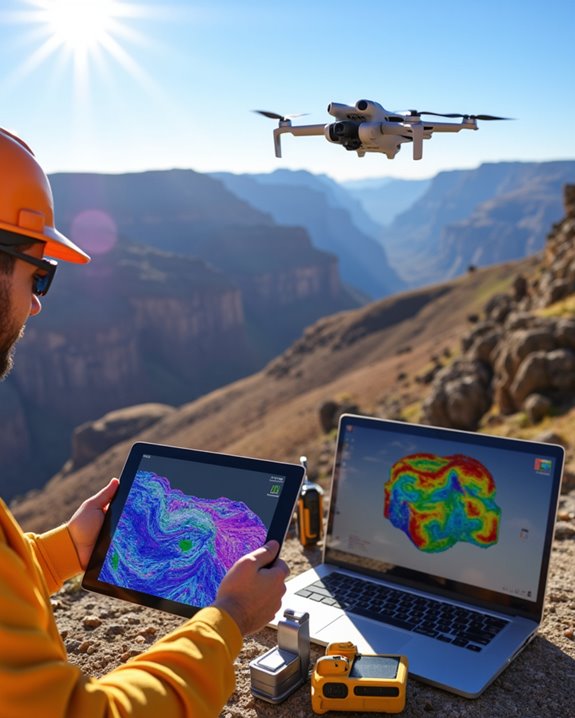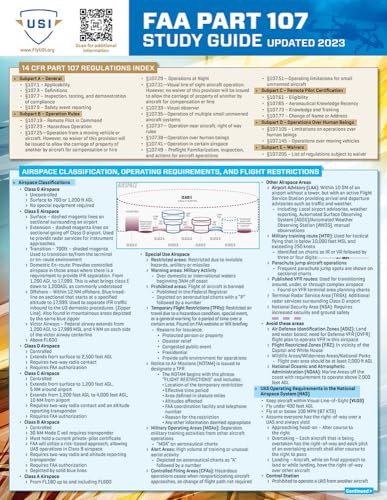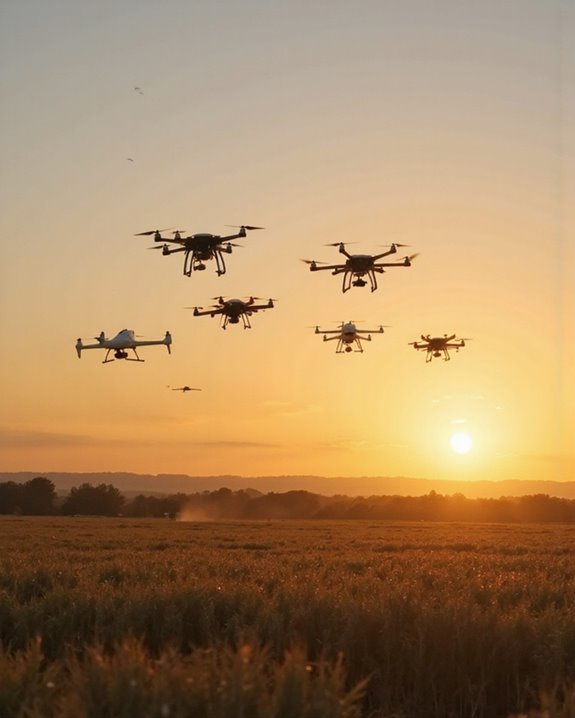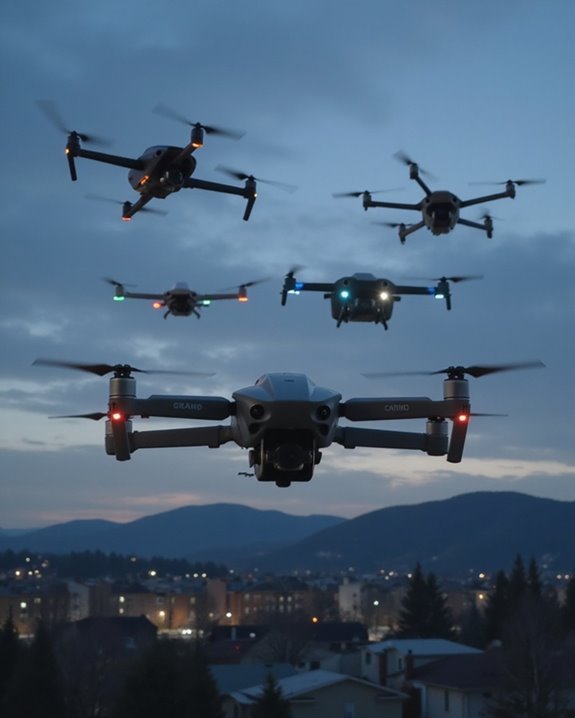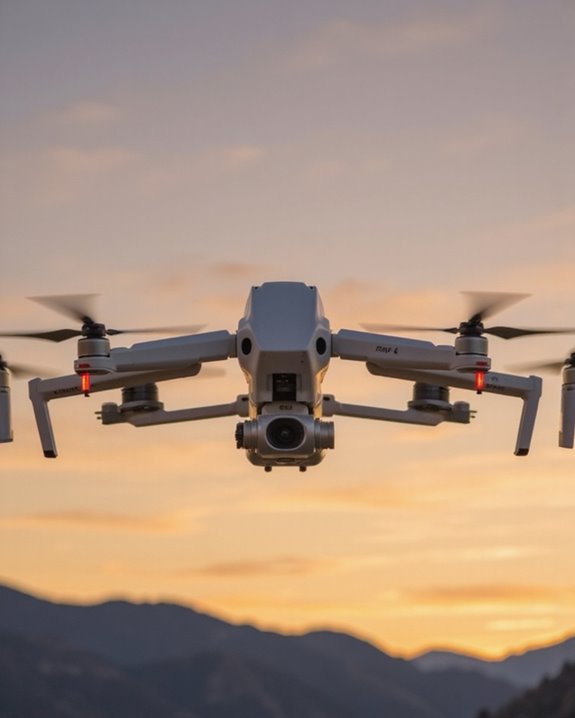Looking for the best drone mapping software in 2025? Professional surveyors recommend systems that combine precision with ease of use! WebODM tops the list with its extensive 3D modeling capabilities, while DroneDeploy‘s user-friendly interface makes it perfect for beginners. You’ll find Pix4D, Agisoft Metashape, and Maps Made Easy offering excellent photogrammetry features at various price points. The right choice depends on your specific mapping needs, flight hardware, and technical expertise. Discover which platform will take your aerial surveys to new heights!
Key Takeaways
- WebODM leads professional surveyor recommendations for its comprehensive 3D model creation capabilities and user-friendly interface.
- Drone mapping software with RTK positioning accuracy of 1cm+1ppm horizontal provides the precision required for professional surveying applications.
- Top-rated programs feature autonomous flight modes including Waypoint, Rectangle, and Polygon patterns for systematic data collection.
- Professional surveyors prioritize software with full ROS compatibility and cross-platform SDK support for integration flexibility.
- Leading mapping solutions offer SLAM technology with 40-meter detection range and 360° angular coverage for detailed environmental mapping.
Holy Stone HS360E GPS Drone with 4K Camera
- Upgraded Drone for Adults: The 𝐇𝐨𝐥𝐲 𝐒𝐭𝐨𝐧𝐞 𝐇𝐒𝟑𝟔𝟎𝐄 is the 𝐞𝐧𝐡𝐚𝐧𝐜𝐞𝐝 𝐯𝐞𝐫𝐬𝐢𝐨𝐧...
- 𝟒𝐊 𝐄𝐈𝐒 𝐂𝐚𝐦𝐞𝐫𝐚 with 𝟏𝟐𝟎𝟎𝐖 𝐒𝐞𝐧𝐬𝐨𝐫: Capture professional-level videos and photos with the drone’s 4K...
- 𝟐𝟎,𝟎𝟎𝟎𝐟𝐭 𝐋𝐨𝐧𝐠-𝐑𝐚𝐧𝐠𝐞 𝐓𝐫𝐚𝐧𝐬𝐦𝐢𝐬𝐬𝐢𝐨𝐧: Enjoy long-distance control and real-time video with...
For professional aerial mappers who need lightweight portability without sacrificing image quality, the Holy Stone HS360E GPS Drone stands out as an exceptional choice. At just 249g, you’ll never need to register this little powerhouse with the FAA—talk about convenient!
You’ll capture stunning 4K footage with electronic image stabilization while the CMOS sensor delivers crystal-clear shots in both RAW and JPEG formats. The impressive 20,000ft transmission range and intelligent flight modes, including waypoint navigation and follow-me functions, make complex mapping projects surprisingly simple. When you’re done, simply fold it up, tuck it into the included carrying case, and you’re off to the next site—mapping has never been this effortless!
Best For: Professional aerial mappers, photography enthusiasts, and recreational drone users seeking a lightweight, portable drone with high-quality 4K imaging capabilities that doesn’t require FAA registration.
Pros:
- Lightweight design (249g) that doesn’t require FAA registration while still offering professional-grade 4K camera with electronic image stabilization
- Impressive 20,000ft transmission range with intelligent flight modes including GPS auto return, follow me, and waypoint navigation
- Highly portable with foldable design, included carrying case, and long-lasting 2100mAh battery capacity
Cons:
- Maximum range of 4 miles may be limiting for users needing extended distance capabilities
- Plastic material construction may affect durability in challenging environments or crash scenarios
- May not offer advanced features found in higher-end professional mapping drones despite its mapping capabilities
FAA Part 107 Drone: A QuickStudy Reference Guide
- Unmanned Safety Institute (Author)
- English (Publication Language)
- 6 Pages - 05/01/2019 (Publication Date) - Unmanned Safety Institute (Publisher)
Aspiring drone pilots who need quick, reliable information will find this QuickStudy Reference Guide an indispensable companion for both exam preparation and in-field flying. The laminated tri-fold packs thorough coverage of essential FAA Part 107 topics, from airspace classification to emergency procedures, all in an easy-to-reference format.
You’ll appreciate having this portable cheat sheet whether you’re cramming for the exam or need a quick refresher before takeoff. While some users note the font is a bit small (bring your reading glasses!), the guide’s organized layout helps you navigate complex regulations with confidence. It even includes the September 2023 Remote ID requirements that you’ll need to know for legal operations!
Best For: Drone enthusiasts studying for the FAA Part 107 certification exam or licensed pilots who want a compact reference guide for quick regulatory checks before flights.
Pros:
- Comprehensive coverage of essential Part 107 topics in a convenient laminated tri-fold format that’s durable for field use
- Includes up-to-date information on Remote ID requirements effective September 2023
- Well-organized layout that helps users efficiently review key regulations and requirements
Cons:
- Small font size may require magnification or reading glasses for some users
- Limited in scope compared to more extensive study materials like textbooks
- May not cover all random questions that could appear on the actual FAA exam
Potensic ATOM 4K GPS Drone with 3-Axis Gimbal for Adults and Beginners
- 【𝐋𝐢𝐠𝐡𝐭𝐰𝐞𝐢𝐠𝐡𝐭, 𝐥𝐞𝐬𝐬 𝐭𝐡𝐚𝐧 𝟐𝟒𝟗𝐠】 The palm-sized drone, ATOM, 𝐝𝐨𝐞𝐬𝐧'𝐭...
- 【𝐑𝐨𝐜𝐤 𝐒𝐭𝐞𝐚𝐝𝐲 𝟒𝐊 𝟑-𝐀𝐱𝐢𝐬 𝐆𝐢𝐦𝐛𝐚𝐥】Equipped with 𝐒𝐎𝐍𝐘 𝐂𝐌𝐎𝐒...
- 【𝟏.𝟑𝐇 𝐅𝐚𝐬𝐭 𝐂𝐡𝐚𝐫𝐠𝐞, 𝟗𝟔 𝐌𝐢𝐧𝐬 𝐋𝐨𝐧𝐠 𝐅𝐥𝐢𝐠𝐡𝐭 𝐰𝐢𝐭𝐡 𝟑...
The ultra-portable Potensic ATOM drone represents the perfect entry point for mapping enthusiasts who don’t want to sacrifice professional-quality imaging. Weighing under 249g, you’ll skip the FAA registration headache while still enjoying a powerful SONY CMOS sensor that captures stunning 4K footage.
You’ll appreciate the impressive 96-minute flight time from three included batteries, making complex mapping projects a breeze! The 3-axis gimbal maintains steady footage even in windy conditions, while features like visual tracking and GPS capabilities transform your mapping workflow. The drone’s compact design fits in your palm, but don’t let its size fool you — this little powerhouse delivers professional results that’ll impress your clients.
Best For: Hobbyist drone enthusiasts and beginning aerial photographers seeking a lightweight, portable option with professional-quality imaging capabilities and no FAA registration requirements.
Pros:
- Impressive 96-minute total flight time with three included batteries and convenient 60W parallel charging hub
- Professional-grade imaging with 4K/30fps video capture, 3-axis gimbal stabilization, and SONY CMOS sensor
- Ultra-portable design under 249g eliminates FAA registration while offering advanced features like GPS tracking and QuickShots
Cons:
- Limited to level-5 wind conditions, which may restrict usage in more challenging weather environments
- 1.3-hour charging time for all three batteries may require planning for extended filming sessions
- Despite marketing for mapping, lacks specialized mapping software or features specifically designed for professional cartography work
Ruko F11PRO 2 Drone with 6K Camera and 3-Axis Gimbal
- 【Soar into Summer Memories】From backyard BBQs to your kid's first bike ride, these are the moments they'll remember. With crisp 6K photos and smooth 4K/30fps video,...
- 【Advanced Image Sensor Lens】F11PRO 2’s premium image sensor lens outshines standard lenses, capturing finer details and richer textures, bringing your world to life...
- 【Stability Redefined】Experience the advantage of our 3-axis brushless gimbal, which provides superior stability and smoothness. With enhanced wind resistance, you can...
Professionals and enthusiasts seeking high-quality aerial mapping capabilities will find the Ruko F11PRO 2 Drone an exceptional tool in their 2025 arsenal! You’ll capture stunning 6K images with the premium sensor that delivers vibrant colors and exceptional clarity—perfect for detailed topographic mapping. The 3-axis brushless gimbal guarantees your footage stays buttery smooth, even when mapping in challenging wind conditions.
With impressive 70-minute flight time using both included batteries, you won’t need to pause your mapping projects midway. The 10,000-foot transmission range lets you cover extensive areas, while GPS-enabled flight modes like waypoint and cruise control make systematic surveying a breeze!
Best For: Hobby photographers and drone enthusiasts looking for a feature-rich drone with extended flight time, good camera quality, and GPS-enabled flight modes at a midrange price point.
Pros:
- Impressive 70-minute total flight time with two included batteries gives ample time for capturing footage
- 6K camera with 3-axis gimbal provides stable, high-quality images and videos even in windy conditions
- Multiple intelligent flight modes (follow-me, orbit, waypoint) make it versatile for different shooting scenarios
Cons:
- The product description claims “10,000 ft transmission range” which may be optimistic under real-world conditions
- At 357g, it requires FAA registration before flight in the United States
- The text exaggerates its capabilities for professional mapping, which would require specialized software not mentioned in the product features
Bwine F7MINI SE GPS Drone with 4K Camera
- 𝟐𝟑𝟖𝐠, 𝐋𝐢𝐠𝐡𝐭𝐰𝐞𝐢𝐠𝐡𝐭: Fly your Bwine F7MINI SE GPS drone without FAA registration, allowing you to focus on capturing those...
- 𝟒𝐊 𝐔𝐇𝐃 𝐂𝐚𝐦𝐞𝐫𝐚: Capture stunning 4K UHD footage from the air with the Bwine F7 GPS drones with camera for adults. It can enjoy 4k quality...
- 𝟕𝟎 𝐌𝐢𝐧𝐬 𝐅𝐥𝐢𝐠𝐡𝐭 𝐓𝐢𝐦𝐞: Equipped with two high-performance batteries, the Bwine GPS drone gives you up to 70 minutes of...
Hobbyist photographers looking for an ultralight mapping solution will find the Bwine F7MINI SE GPS Drone exceptionally valuable for their aerial imaging needs. At just 238g, you won’t need FAA registration—meaning you can start mapping right away! The 4K UHD camera delivers crisp footage perfect for basic terrain mapping projects, and you’ll love the convenience of gesture control for hands-free operation.
You’ll get an impressive 70 minutes of flight time using both included batteries, giving you plenty of opportunity to capture your entire site. The GPS positioning and automatic return features guarantee your mapping assistant always finds its way home safely, even when your coffee break runs long!
Best For: Hobbyist photographers and drone enthusiasts seeking an ultra-lightweight, registration-free drone with good camera quality for casual aerial photography and basic mapping projects.
Pros:
- Lightweight at 238g with no FAA registration required, making it accessible for beginners and convenient for travel
- Impressive 70-minute total flight time with two batteries and nearly 10,000 feet range for extended shooting sessions
- Comprehensive safety features including GPS positioning, automatic return home, and multiple positioning systems
Cons:
- 4K camera likely offers basic quality compared to professional-grade drones, with limited low-light performance
- Lacks advanced stabilization systems found in higher-end photography drones
- “Follow me” and other intelligent features may have limitations in performance compared to premium models
OpenDroneMap: The Missing Guide – Practical Drone Mapping Guide
- Toffanin, Piero (Author)
- English (Publication Language)
- 308 Pages - 06/18/2023 (Publication Date) - Independently published (Publisher)
Diving into the open-source world of drone mapping requires a thorough resource, which is exactly what you’ll find in “OpenDroneMap: The Missing Guide.” This practical guidebook stands out as an excellent reference for technically-inclined users who’ve moved beyond basic drone operations and want to access the full potential of photogrammetry without costly proprietary software.
You’ll appreciate how it systematically demystifies the WebODM interface, explaining why certain settings matter for your 3D models. The book isn’t for beginners—expect a moderate learning curve! One heads-up: some users find the command line chapter’s focus on Docker frustrating, as the non-Docker Windows version offers better CPU utilization. Still, you won’t find a more detailed guide to tweaking input parameters beyond what those quick online tutorials offer!
Best For: Technical users who want to maximize open-source drone mapping capabilities without spending money on expensive proprietary photogrammetry software.
Pros:
- Provides comprehensive explanation of WebODM interface and settings that affect 3D model creation
- Offers systematic presentation of the entire software system rather than fragmented information
- Excellent reference for tweaking input parameters beyond default settings
Cons:
- Not suitable for beginners due to moderate to high learning curve
- Command line chapter focuses on Docker version despite performance limitations
- Docker version allocates only half the CPU cores and memory compared to non-Docker Windows version
Autel Robotics EVO II PRO RTK V3 Drone with 6K Camera
- 【AUTEL ROBOTICS USA AUTHORIZED】We are the longest and largest distributors of Autel Robotics. Over the years, we have maintained a close partnership with Autel,...
- 【2025 NEWEST RTK MODULE FOR REAL-TIME CENTIMETER-LEVEL POSITIONING】With 1 cm + 1 ppm (horizontal), 1.5 cm + 1 ppm (vertical) positioning accuracy, Autel EVO 2 Pro RTK...
- 【MISSION EXECUTION WITH ADVANCED INTELLIGENCE】After creating a flight route(Waypoint Task丨Rectangle Task丨Polygon Task丨Oblique Photography), the EVO II RTK can...
Surveying professionals who demand centimeter-level precision will find their perfect match in the Autel Robotics EVO II PRO RTK V3. This powerhouse drone delivers impressive 1cm+1ppm horizontal accuracy that’ll make your mapping projects shine! You’ll capture stunning 6K footage with the Sony HDR camera while enjoying a generous 38-minute flight time.
Say goodbye to ground control points forever! The advanced RTK module offers real-time centimeter-level positioning, working seamlessly with base station networks and PPK functionality. Your autonomous mapping missions—Waypoint, Rectangle, Polygon, or Oblique Photography—have never been easier. Plus, it’s compatible with Carlson PhotoCapture for creating surfaces and point clouds that’ll make your clients say “wow!”
Best For: Professional surveyors, urban planners, and mapping specialists seeking centimeter-level positioning accuracy for photogrammetry and data acquisition projects requiring precise geospatial information.
Pros:
- Delivers exceptional positioning accuracy with 1cm+1ppm horizontal and 1.5cm+1ppm vertical precision through its RTK module
- Impressive 38-minute flight time and 15km transmission range maximize productivity in the field
- Versatile autonomous flight modes (Waypoint, Rectangle, Polygon, Oblique Photography) streamline complex mapping missions
Cons:
- Significant investment at a higher price point compared to consumer drones
- Substantial weight at 21.4 pounds may limit portability in remote field operations
- Limited user feedback with only 2 reviews available to validate long-term reliability
N11 PRO GPS Drone with 4K Camera for Adults
- 【Under 0.55lb Mid-sized Drone, No FAA Registration】Designed with a unique material composition, the N11 PRO is a remarkably valuable mid-sized GPS drone (not mini...
- 【Brushless Motors & Long Flight Time and Control Range】Enduring alloy brushless motors feature strong wind resistance and provides a faster, quieter while more...
- 【Dual Positioning System】Optical Flow Positioning provides you a safer indoor flight while GPS Positioning gives a more free and stabilized outdoor flight. They also...
The ultimate companion for aerial mapping enthusiasts, the N11 PRO GPS Drone packs professional-grade features into a lightweight, travel-friendly design that won’t require FAA registration. You’ll enjoy an impressive 90 minutes of flight time using all three batteries, giving you plenty of opportunity to capture your entire mapping project in one session!
With dual positioning systems that adapt to your environment—Optical Flow for indoor precision and GPS for outdoor stability—you’re equipped for versatile mapping scenarios. The 4K UHD camera delivers crystal-clear imagery with adjustable wide-angle views, while intelligent flight modes like Follow Me and Point of Interest make complex mapping patterns a breeze. Who knew professional-grade mapping could fit in a carrying case?
Best For: Aerial photography and mapping enthusiasts who need a portable, registration-free drone with extended flight time and intelligent navigation features.
Pros:
- Impressive 90-minute total flight time with three batteries allows for extended mapping and photography sessions
- Lightweight design under 0.55lb eliminates FAA registration requirements while maintaining professional features
- Dual positioning systems (Optical Flow for indoors, GPS for outdoors) provide versatile operation in various environments
Cons:
- 4K camera limited to 2048×1080 video resolution, which is not true 4K video quality
- 3328-foot control range may be insufficient for advanced aerial mapping of larger areas
- 5GHz FPV transmission may experience interference or reduced range in areas with obstacles or electronic interference
Slamtec RPLIDAR M2M3 Mapping Lidar Sensor Scanner for Robotics
- [High Accuracy] Upgraded version Slamtec M2M3 lidar rangefinder kit support measuring Range: 0.1m - 40m; Rotational Speed: 8Hz-15Hz; Angular Range: 360°; Frequency:...
- [Data Communication interfaces] Slamtec M2M2 Mapper fully compatible with ROS, Fast,Accurate and easy data analysis; Built-in 10/100M Ethernet (802.3/802.3u ), WiFi...
- [SLAM Real-time Mapping] SLAMTEC M2M3 lidar sensor scanner has built-in SLAM real-time map building and localization function, which is suitable for robot navigation and...
Professional drone mappers who need exceptional range and precision will find their perfect match in the Slamtec RPLIDAR M2M3 Mapping Lidar Sensor. With its impressive 40-meter range and 360° angular coverage, you’ll capture complete environmental data in a single pass. The built-in SLAM technology with SharpEdge enhancement delivers stunningly accurate maps covering up to 300m x 300m areas.
You’ll appreciate the versatile connectivity options, including Ethernet and WiFi, plus full ROS compatibility for seamless integration into your existing workflow. At just 6.3 ounces, it won’t weigh down your drone! The extensive SDK supports multiple platforms, making custom development a breeze—exactly what you’d expect from 2025’s mapping technology.
Best For: Professional robotics engineers and hobbyists requiring high-precision environmental mapping and navigation capabilities for autonomous robot development.
Pros:
- Impressive 40-meter detection range with 360° coverage allows for comprehensive environmental scanning and detailed mapping
- Multiple connectivity options (Ethernet and WiFi) with full ROS compatibility makes integration into existing robotic systems straightforward
- Comprehensive software support including complete SDK, ROS drivers, and RoboStudio software across multiple platforms
Cons:
- The December 2024 release date listed as “Date First Available” indicates this is a very new product that may have limited real-world testing and user feedback
- At 6.3 ounces, it’s lightweight for robotics but may be too heavy for smaller drone applications despite marketing claims
- Low sales rank (#755,567 in Industrial & Scientific) suggests limited market adoption or availability issues compared to more established lidar sensors
Sky High Bulls-Eye Drone Ground Control Point GCP (10 Pack) for Mapping & Surveying
- Efficient Mapping: The novel center cutout design of the uav drone gcp markers enables seamless mapping with pre-established survey markers. Simply align your drone's...
- Secure Ground Placement: Each aerial target ground marker is equipped with four corner anchor points, allowing for easy and reliable affixation to the ground. Ensure...
- Easy Identification with Numbering: The numbered markers feature clear and distinct numbering from 0 to 9, facilitating easy identification of individual targets. Quickly...
Ground control precision reaches new heights with this innovative 10-pack of Bulls-Eye GCPs, perfect for surveyors who demand accuracy without compromise. You’ll love how each marker features a clever center cutout that aligns seamlessly with existing survey points while remaining visible from up to 300 feet away!
These foldable, lightweight GCPs won’t let you down when the wind picks up, thanks to their four corner anchor points with metal seal rings. They’re numbered 0-9 for easy identification and compatible with popular platforms like Pix4D and DroneDeploy. For professional results without professional headaches, these durable markers make even the toughest terrain mapping feel like a walk in the park!
Best For: Professional surveyors, drone mapping specialists, and GIS professionals who need accurate ground control points for precise aerial mapping and surveying projects.
Pros:
- Highly visible black and white markers with clear numbering (0-9) can be spotted from up to 300 feet away, ensuring efficient data capture
- Four corner anchor points with metal seal rings and stakes provide excellent stability even in windy conditions
- Compatible with popular mapping software like Pix4D and DroneDeploy, with a center cutout that aligns with existing survey markers
Cons:
- Lightweight material may require additional securing in extremely challenging terrain or high-wind environments
- Limited to 10 GCPs in the pack, which may not be sufficient for very large survey areas
- No indication of whether replacement stakes are included if originals are lost or damaged
Factors to Consider When Choosing Drone Mapping
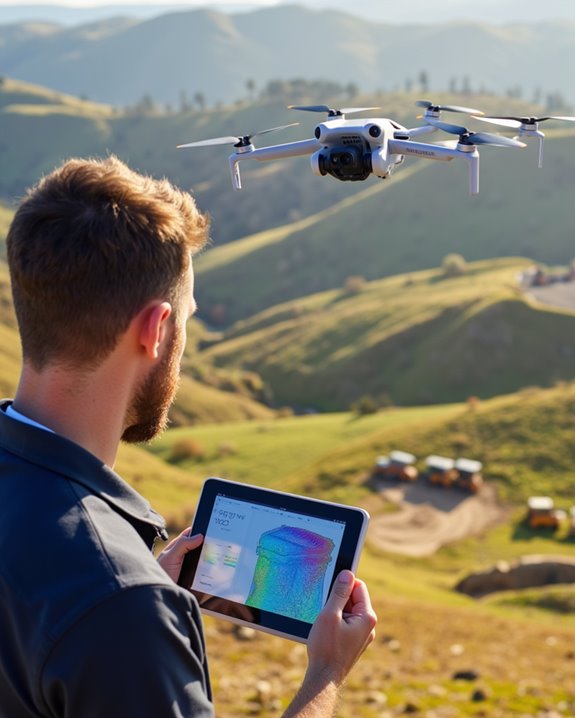
When you’re selecting the right drone mapping solution for your projects, there are several critical factors that’ll make or break your aerial surveying success. You’ll need to weigh everything from camera quality (those megapixels really count for detailed orthomosaics!) to battery life, GPS accuracy, wind stability, and the processing power of your software. Your mapping results will only be as good as the weakest link in your drone setup, so don’t skimp on the essentials that match your specific mapping needs!
Camera Quality Matters
Although software capabilities are essential for drone mapping success, your camera’s quality ultimately determines the raw material you’ll be working with! The resolution you choose makes a substantial difference—4K or 6K cameras capture incredibly detailed images that transform into precise, accurate maps you can truly rely on.
Don’t overlook electronic image stabilization technology, which keeps those pesky vibrations from ruining your shots. Modern CMOS sensors are game-changers too, handling tricky lighting conditions that would have wrecked your mapping projects just a few years ago! For thorough 3D modeling, you’ll want cameras recording at 30fps or higher, trust us on this one. And if you’re mapping challenging terrain, a camera with a 3-axis gimbal will be your best friend, reducing distortions and delivering the spatial accuracy your clients expect.
Battery Life Considerations
The lifeblood of your drone mapping operations directly depends on battery performance, which can make or break even the most carefully planned projects! When selecting your mapping setup, prioritize drones offering extended flight times—up to 96 minutes for thorough coverage without those frustrating mid-survey landings. Batteries with 3000mAh+ capacity will serve you best, especially when mapping multiple locations in one day.
Don’t forget that Mother Nature loves to complicate things! Windy conditions can slash your battery efficiency by 20-30%, so always pack spares. With a smart battery rotation system, you’ll maintain over 90 minutes of total operation through quick swaps. Just remember that higher-capacity batteries add weight—a classic surveyor’s dilemma where power comes at the expense of 10-20 minutes of precious flight time!
GPS Positioning Accuracy
Beyond battery concerns lies perhaps the most foundational aspect of your drone mapping arsenal—GPS positioning accuracy! The difference between amateur and professional results comes down to how precisely your drone knows where it is at any given moment. Today’s top systems can achieve horizontal accuracies around 1 cm plus 1 ppm under ideal conditions—that’s incredibly precise!
You’ll want to look for mapping software that integrates seamlessly with RTK technology, which corrects GPS signals in real-time and delivers vertical precision of about 1.5 cm plus 1 ppm. Environmental factors will always try to sabotage your accuracy (pesky atmosphere!), but software that supports differential correction methods can transform meter-level errors into centimeter-level precision. For true survey-grade results, make sure your chosen software plays nice with base stations or offers PPK capabilities—your 3D models will thank you!
Stability in Wind
Gusty conditions won’t derail your mapping missions when you’ve selected software that works harmoniously with wind-resistant drone hardware! The best mapping solutions in 2025 leverage brushless motor technology that reduces vibrations, giving you rock-steady flight even when the breeze picks up.
You’ll want software that integrates with electronic image stabilization features, automatically adjusting for those inevitable shakes without compromising data quality. Look for platforms compatible with drones rated for level-5 winds—these workhorses keep collecting precise data while lesser models are grounded! The magic happens when aerodynamic design meets intelligent GPS systems that correct for drift in real-time. Remember, even the slickest software can’t rescue poorly captured footage, so choose hardware with robust wind performance. Your clients will never know you mapped during a blustery day!
Data Processing Capabilities
Powerful processing capabilities form the backbone of any elite drone mapping software in 2025, determining whether your aerial data becomes actionable intelligence or just pretty pictures! You’ll want software that delivers centimeter-level accuracy while efficiently handling massive datasets of up to 100,000 square meters without breaking a sweat.
Look for systems that support high sampling frequencies—32kHz is now the gold standard—ensuring you capture every detail in real time as your drone glides through the air. The best solutions allocate multiple CPU cores and ample memory to tackle complex photogrammetry tasks without those frustrating processing bottlenecks. And don’t overlook SLAM integration! This game-changing technology provides real-time localization and crisp edge detection, turning what used to be a processing headache into mapping magic that would make your old GPS unit blush with inadequacy.
Regulatory Compliance Requirements
Steering regulatory waters might seem less exciting than processing high-resolution imagery, but your cutting-edge software won’t help much if your drone operation gets grounded by the FAA! The best mapping software in 2025 includes built-in compliance features that streamline adherence to Part 107 regulations.
Look for solutions that automatically flag restricted airspace, integrate Remote ID broadcasting capabilities (mandatory since September 2023!), and provide pre-flight checklist tools. You’ll want software that tracks your sub-250g drone exemptions and maintains digital flight logs for regulatory inspections.
Top-tier programs now include emergency procedure protocols and weather assessment tools directly in their interfaces. Remember, compliance isn’t just about avoiding fines—it’s about ensuring your mapping operations continue uninterrupted while maintaining the highest safety standards possible!
Frequently Asked Questions
How Does Drone Mapping Software Handle Accuracy in Varying Terrain Conditions?
Ever wondered how drones map accurately when hills, forests, and valleys get in the way? You’ll find that modern drone mapping software compensates for terrain variations using ground control points, RTK/PPK technology, and sophisticated algorithms. These systems adjust for elevation changes, automatically detect features, and create 3D meshes to represent complex landscapes. Many programs even filter vegetation to reveal true ground surfaces! The best software lets you calibrate accuracy settings based on your project’s needs, ensuring reliable data even in challenging conditions.
Can Drone Mapping Software Integrate With Existing GIS Systems?
Yes, you’ll find that most drone mapping software integrates seamlessly with popular GIS systems! Your drone data can flow directly into platforms like ArcGIS, QGIS, and Global Mapper through standard file formats (GeoTIFF, LAS, SHP). This connectivity lets you combine fresh aerial imagery with existing datasets, creating richer analysis possibilities. Some solutions, like DroneDeploy and Pix4D, offer dedicated plugins for even smoother workflows. No more tedious data juggling between separate systems!
What Training Is Required to Effectively Use Professional Mapping Software?
You’ll need basic GIS fundamentals and drone operation skills before diving in! Most professional mapping software requires training in photogrammetry principles, data processing workflows, and spatial analysis techniques. Many companies offer certification programs, like Pix4D’s Professional Certification or DroneDeploy’s Academy courses, to get you up to speed. Don’t worry though—many platforms provide tutorials, webinars, and support communities that make the learning curve less intimidating. Practice with sample datasets for hands-on experience!
How Do Different Software Options Handle Large Datasets?
Imagine mountains of data flowing like digital rivers through your mapping software! You’ll find most professional options handle large datasets differently. Pix4D offers cloud processing for massive projects, while DroneDeploy excels with speedy local processing that won’t bog down your computer. Many solutions, like Agisoft Metashape, let you “tile” your data into manageable chunks. When working with those gigabyte-heavy files from your latest survey, look for software with batch processing capabilities – they’re absolute lifesavers!
Are There Subscription-Based Options Versus One-Time Purchase Mapping Software?
Yes, you’ll find both pricing models in the drone mapping world! Popular subscription options include DroneDeploy and Pix4D Cloud, which offer monthly plans starting around $99, with the benefit of regular updates. For one-time purchases, look at Global Mapper ($499) or Agisoft Metashape ($3,499), which give you perpetual licenses without recurring fees. Your choice depends on cashflow preferences and how frequently you’ll use the software. Most companies offer free trials too, so you can test before committing!

